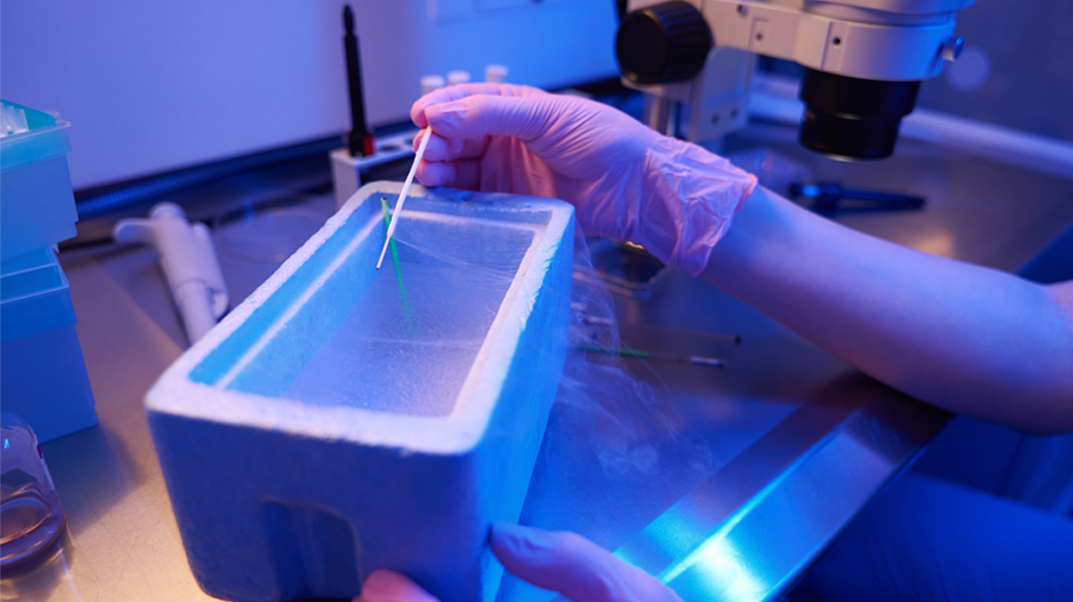Table of contents
If you are undergoing an in vitro fertilisation (IVF) treatment and you have been told that your embryos are going to be frozen, it is normal for you to have a ton of questions: Why aren’t they transferred straight away? Can this affect my chances of getting pregnant? Is it safe for the embryos? Freezing embryos is very common and, in most cases, is a decision made to increase the chances of successful treatment.
Below, in layman’s terms, we are going to explain why it is sometimes necessary to freeze embryos and how this process is not only safe, but can be the key to fulfilling the dream of having a baby, even several times over.
Why freeze embryos?
During IVF treatment, after ovarian stimulation, egg retrieval and fertilisation, several embryos can be obtained and kept in culture for up to 6 days. If it is not possible to transfer them in that time, we can cryopreserve them for future use.
What are the most common reasons for freezing embryos?
- When it is not possible to transfer them in the same cycle as the stimulation: Your body may not yet be ready to receive the embryo at that time. For example, if the endometrium is not receptive because it has not thickened sufficiently, or if there is a risk of ovarian hyperstimulation syndrome. In these cases, it is best to cancel the embryo transfer, freeze the embryos and wait for the next cycle.
- Surplus embryos: After transferring a fresh embryo, leftover embryos can be saved for future attempts or to expand the family at a later date.
- Preimplantation genetic diagnosis (PGD): If a biopsy is necessary to analyse the embryos, we will have to freeze them, as the results may take several days.
- Synchronisation in ovodonation: In egg donation treatments, it is possible that the donor and recipient may not have synchronised cycles. If so, the embryos obtained are vitrified until the right time for transfer.
Advantages of embryo freezing
Embryo vitrification has made it possible to fully optimise IVF treatments. In this way, if the endometrium is not ready, if there is a risk of hyperstimulation or any other circumstance that may hinder pregnancy, we can cancel the transfer and freeze the embryos until the optimal conditions are met to increase the success rate. As a result, the cumulative pregnancy rate, i.e. the pregnancy rate per puncture with a single cycle of ovarian stimulation, has increased in recent years.
By being able to freeze the embryos for future attempts, the physical and emotional toll on the patients is much less, as they can access their embryos without having to go through the whole process of hormone medication again. Like this, the impact on their physical and emotional wellbeing is greatly reduced.
In addition, embryo vitrification has also helped to reduce the rate of multiple pregnancies, as we can transfer embryos one at a time and carefully preserve the others for future occasions.
Another great advantage of being able to freeze embryos is that it is possible to better plan motherhood, which is necessary for women with cancer or other pathologies that force them to postpone pregnancy.
All these advantages are possible thanks to the vitrification technique, which offers an embryo survival rate of over 90%.
What is embryo vitrification?
Vitrification is the most advanced and safest technique for freezing embryos. For years, slow freezing was used for embryo cryopreservation until the advent of the vitrification technique gradually replaced this method.
Vitrification involves ultra-rapid freezing, which has been instrumental in the cryopreservation of oocytes. With the old slow freezing technique, the high-water content caused the formation of ice crystals inside the embryos, affecting their quality. Vitrification, on the other hand, prevents the formation of ice crystals, which are the main cause of cell damage during freezing.

To do this, embryos are first prepared by immersing them in cryoprotective solutions that remove water from the cells and protect them from freezing damage. They are then rapidly immersed in liquid nitrogen at -196°C, which solidifies the cells instantly, as if turning them into glass. Finally, the vitrified embryos are stored in liquid nitrogen tanks until they are ready for use.
The process of embryo devitrification is also quicker and easier than with other techniques. Simply remove the embryo straw from the liquid nitrogen tank and place it directly into a 37 °C medium. The embryos are then passed through various culture media to achieve cell rehydration.
In this way, thanks to vitrification, the embryos retain practically the same quality, and the pregnancy success rates are similar to those of fresh embryos.
How is the transfer of frozen embryos carried out?
When transferring the embryo, we must make sure that the uterus is ready to receive it. To do this, we can choose between two processes, depending on each case:
Frozen embryo transfer in artificial or surrogate cycle
This method is ideal for women who do not ovulate regularly. It consists of administering medication, by mouth or in patches, containing oestrogen and progesterone to prepare the endometrium, from the onset of menstruation.
In the days prior to cryotransfer, progesterone eggs will have to be administered vaginally. This medication will be administered until the 10th-12th week of pregnancy.
Once we have checked that the endometrium is receptive, it is time to thaw the embryo and transfer it to the uterus.
Transfer of frozen embryos in a natural cycle
In women with regular menstrual cycles, we can take advantage of their natural cycle. Thus, the preparation of the endometrium is achieved through the oestrogen and progesterone produced naturally by the growing ovarian follicle for about two weeks. When, by ultrasound, we detect that ovulation is going to take place, we administer a single injection of HCG and we also start administering progesterone eggs vaginally, which will be administered until the end of the first trimester of pregnancy.
One week after ovulation, the transfer takes place, as this is the time when the endometrium is most receptive.
The survival rate in devitrified embryos depends both on the viability of the embryo and tolerance to the freezing and thawing processes, as well as on the compliance with these pre-transfer procedures established in the protocols.
In short, embryo vitrification is a safe technique and, as outlined, offers multiple advantages that increase the IVF treatment success rate.
If you have any doubts about embryo freezing or need personalised advice for your assisted reproduction treatment, the team at clínica Tambre is here to help you. We have experts who will be with you every step of the way, addressing your concerns and ensuring you make the most informed decisions. Don’t hesitate to contact us and request a first consultation at Tambre now. We want to help you make your dream of starting a family come true.


